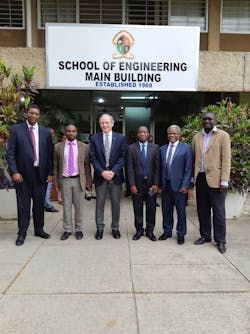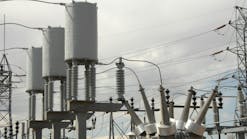African Nations Seek to Bolster Power Infrastructure, Provide Universal Access
Author’s note: I offer the following account not as an expert on African electric power and access issues, but as a member of a global community of electrical engineers and related subject matter experts whose primary role in this world is to assess practical challenges and to somehow meet them – in short, to “get things done.”
In late 2018, in Lusaka, Zambia, a conference room packed with local electric power utility CEOs, technical directors, regulators, educators, and students listened intently as I offered my view of solutions to their myriad challenges.
My remarks were not business-as-usual prescriptive advice. I had already grasped many of their diverse challenges, having listened with great interest to an African delegation on a reverse trade mission to the United States in late February, early March 2018, sponsored by the U.S. Trade Development Agency.
The African delegation, with representatives from Ethiopia, Kenya, Uganda, and Rwanda, had described aging infrastructure, underinvestment, and reliability and capacity issues. These challenges are also common in the developed world, yet in Africa, where these issues affect many nations in the African Union, the need to resolve them is significantly greater.
One of the most vexing, pan-African challenges is the electrification divide between urban and rural areas. Just under 50% of Ethiopia’s population, for example, has access to electricity. While 86% of its urban population has access, more than 70% of its rural population does not. At the other end of the spectrum, only 20% of Uganda’s population has access to electricity and the need for access is so pervasive that the urban-rural divide is negligible.
The challenge is obvious, yet the situation is not wholly dissimilar from the United States, which passed the Rural Electrification Act of 1936 to bring electric power to vast swaths of previously unserved rural farms and ranches. One key difference today is that forward-looking development strategies and advanced technologies offer a diverse toolkit with which to address universal access and the urban-rural divide in Africa.
A plan to overcome the African Union’s challenges in the electric power sector and beyond is articulated in the United Nations’ Sustainable Development Goal 9: “Build resilient infrastructure, promote inclusive and sustainable industrialization and foster innovation.” This goal obviously provides an umbrella that covers many infrastructure sectors. Because my specific expertise is in electric power generation, transmission and distribution (T&D) – both in transforming aging infrastructure and implementing advanced technologies – I and my sponsor, the IEEE Power and Energy Society/IEEE Ad Hoc Committee on Africa (AHCA), felt we had much to offer last fall to audiences in Zambia and Ghana.
Reliable, resilient electricity and citizens’ affordable access to it is critical to industrialization, transportation, health care, education, communication – everything that citizens in developed nations largely take for granted and that support sustainable societies and economies.
In this two-part article for T&D World, I’ll first relate my experiences in Zambia. Part Two, in next month’s issue, will include the Ghana portion of my journey and offer some conclusions.
Zambia’s needs and goals
In Zambia, a country in southern Africa slightly larger than Texas, the population of 16.5 million is highly urban with the highest densities in the capital of Lusaka, and Ndola, Kitwe and Mufulira. Though 67% of Zambia’s urban population has access to electricity, it is often unreliable. Only 6% of its rural population has access to electricity. More than 10 million people lack access. Overall, that’s 60% of the population without access. On the other hand, Zambia has abundant natural resources as 93% of its electricity comes from hydropower. Only 5% derives from fossil fuels and 2% from renewable energy.
Thus, last fall in Lusaka, I addressed a diverse audience with a different focus for each stakeholder, on topics ranging from Smart Grid strategy and policy, renewable energy integration, microgrids, security/privacy, and workforce development, among other topics.
Wherever I spoke, the conference rooms were packed. My audiences listened with rapt attention and the question-and-answer sessions featured robust give-and-take. Attendees exhibited intense interest in their challenges, and many focused on aging infrastructure, underinvestment, and the best technological paths forward. I noted that, in fact, these are topics of intense interest in the United States as well.
Several participants wanted to discuss cybersecurity in detail. I introduced fundamental concepts and discussed the hacking of the Ukrainian power grid in December 2015, which caused a blackout in Kyiv but was intended to cause physical damage. I reviewed the anatomy of the hackers’ actions over a nine-month period to prepare for and execute the attack. 10 African members of the IEEE Grid Code Technical Committee participated in a session on the grid impacts of renewable energy resources and microgrids (topics to which I’ll return).
Participants requested my PowerPoint presentations, as well as articles and books I’ve written. At the University of Zambia, I led interactive discussions on grid modernization, cybersecurity, and asset performance management. In the wake of my visit, Choolwe Nalubamba, who is responsible for telecommunications and information systems at Copperbelt Energy Corporation Plc in Kitwe, Zambia, requested my materials on cybersecurity. I pledged to remain a resource going forward.
The Zambians’ level of interest is understandable. According to the United States Agency for International Development’s (USAID) Power Africa project on Zambia’s goals and challenges, in 1996 the Zambian government set a goal of universal electricity access for all Zambians by 2030. “Energy,” including electrification, is recognized as a driver of economic development. Yet, the USAID notes, “although there is reason for optimism, the decade between 2020 and 2030 would have to see significant gains to attain this goal.” The most important measures in achieving universal access, according to the USAID, include continued market-based reforms, establishing the creditworthiness of the offtaker, growing government debt that inhibits investment, and a lag in T&D capacity.
As I boarded a plane for Ghana in West Africa, I began receiving emails from the people I had just addressed in Lusaka. Joseph Mutale, a native Zambian, who currently serves as professor of sustainable energy and electric power systems, and director of social responsibility, at the School of Electrical and Electronic Engineering, University of Manchester in the United Kingdom, wrote, “You certainly made a long-lasting impact [in Zambia].”
I can report that the reverse is true as well. A Zambian gentleman named Sebastian Namukolo sent me an email reflecting his view of various practical challenges in his country that provided both the flavor of the challenges and one man’s hunger for solutions.
“Our public solar projects are becoming unsustainable because of lack of maintenance and frequent damage caused by weather,” Namukolo wrote to me. “In Zambia, weather can be catastrophic. Electronic, integrated-circuit [power] inverters are frequently struck by ferocious tropical lightning. The [resulting] damage is aggravated because the original installations did not follow best practices for grounding, surge, and lightning protection. Repairs are hampered because these products are sourced from outside Zambia and there’s no local manufacturer representative. Replacement of damaged inverters is therefore uneconomical. These factors have led to many abandoned projects.”
“In Zambia and many other African countries,” Namukolo continued, “we understand theory but lack practical experience in implementing solutions. We need support from mentors with experience. I work with a group of very sharp young students and we are trying to do two things this coming year: design a local 10- to 20-kW inverter for deployment to rural, offgrid communities, and design a millimeter-wave prototype for foreign object monitoring and identification on [airport] runways.”
“I am wondering if you will be in a position to connect me and my students to people with experience willing to guide the designs to final reliable prototype products,” Namukolo concluded. “We are only asking for knowledge.”
In Ghana’s capital, Accra, I held similar talks with executives from distribution, transmission and generation utilities, regulators, policy makers, university professors, and students. And I experienced similar outreach from individuals hungry for knowledge.
In Part Two, the author will report on his time with IEEE leaders in Ghana.



